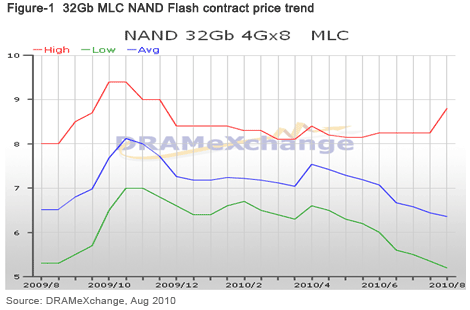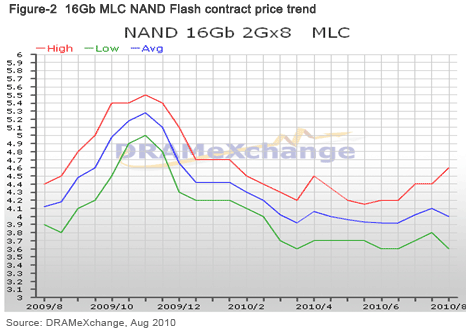

1HAug. mainstream NAND Flash contract price indicate mild ups and downs for different customer mix
Aug 19th,2010------According to DRAMeXchange, the research division o TRENDORCE,1HAug. mainstream NAND Flash contract price indicates mild ups and downs given the different pricing strategy and different customer mix that NAND Flash vendors have. Since hot season orders from system product customers have warmed up from end of July, NAND Flash vendors with higher exposure in system product customers raise 4%-6% MLC contract price for system product applications.
In contrary, demand from memory card and UFD is still weak and customers are still digesting their original inventory and expect vendors adjust down chip price for the summer promotion. That is, NAND Flash vendors with higher portion in memory card and UFD customers slightly lower 2%-5% TLC and MLC contract price for memory card & UFD applications accordingly. Overall, 1HAug NAND Flash contract price indicated partial steady and decline responding to the different customer mix and applications.
Impact by the global financial crisis and, the demand pattern of electronics products will differ from the historical pattern in 2H10. In 1H10 Asia Pacific and emerging markets with more stable economic growth have played the important role in maintain WW electronic product demand growth momentum. Says DRAMeXchange.
Nevertheless, the 2H10 hot season demand for electronic products may merely surpass the demand in 1H11 due to market concerns on the slowly economic recovery in USA and Europe . DRAMeXchane expect the NAND Flash demand for 2H10 inventory replenishment to be still superior to demand in 1H10 benefited from the new model launch effect from high-capacity smart phones and tablet PCs. Nevertheless, supply in 2H10 will increase with the output boost of new 2xnm & 3xnm process technology. Customers also expect for the lower NAND Flash price to stimulate the content per system for NAND Flash storage and for 2H hot season promotions. Along with the TLC replacement effect in memory card and UFD, momentum of 2H10 NAND Flash price rebound will be limited that the hot season effect will be different from the traditional hot season pattern.
Inventory replenishment for system product customers has warmed up in end of July while restock demand for memory card and UFD will likely rebound after end of August. After inventory replenishment peak from system product customers in October, NAND Flash price will decline in line with the cost down effect from process technology migration due to the coming slow season effect. Even so, demand from system product customers will help offset the impact on weaker demand in memory card and result in the relatively stable pricing trend before late October. DRAMeXchange indicate that varied pricing strategy will be applied by different suppliers in terms of different customer base and different order status during the 2H restock demand peak period.


Subject
Related Articles
Related Reports

